Submitted:
22 August 2024
Posted:
23 August 2024
You are already at the latest version
Abstract
Keywords:
1. Introduction
2. Material and Methods
2.1. Experimental Design
2.2. The Soils Characterization
2.3. Water Treatment
2.3. Water and Soil Physicochemical Analysis
2.3.1. Soil Water Content Measurement
2.3.2. Bulk Density
2.3.3. Soil Electrical Conductivity
2.3.4. Drainage Water pH
2.3.5. Salt Analyses
2.3.6. Data Analyses
3. Results and Discussion
3.1. Effect of Saline Water TE on Soil Salt Leaching Efficiency
3.1.1. Effect of ET on Salt Leaching in Response to Irrigation Water Salinity
Effect of ET on Soil Water and Salt Contents
3.1.2. Effect of the ET on Soil Salt Leaching in Response to Irrigation Dose
3.2. Effect of TE Duration on Drainage Water and Soil
3.2.1. Effect on Drainage Water
3.2.2. Effect on Soil Water and Salt Contents
Conclusion
Acknowledgments
References
- Vaghefi S A, Mousavi S J, Abbaspour K C, Srinivasan R and Yang H 2014 Analyses of the impact of climate change on water resources components, drought and wheat yield in semiarid regions: Karkheh River Basin in Iran Hydrol. Process. 28 2018–32. [CrossRef]
- Daliakopoulos I N, Tsanis I K, Koutroulis A, Kourgialas N N, Varouchakis A E, Karatzas G P and Ritsema C J 2016 The threat of soil salinity: A European scale review Sci. Total Environ. 573 727–39. [CrossRef]
- Famiglietti J S 2014 The global groundwater crisis Nat. Clim. Change 4 945–8. [CrossRef]
- Taimourya H, Bourarach E-H, Harif A E, Hassanain N, Masmoudi L, Baamal L and Oussible M 2015 Évaluation de la productivité du chou pommé (Brassica oleracea), sous l’effet de l’irrigation avec une eau traitée magnétiquement, dans la région de Casablanca (Maroc) Rev. Marocaine Sci. Agron. Vét. 3 27–36.
- Wada Y, Lo M-H, Yeh P J-F, Reager J T, Famiglietti J S, Wu R-J and Tseng Y-H 2016 Fate of water pumped from underground and contributions to sea-level rise Nat. Clim. Change 6 777–80. [CrossRef]
- Khaskhoussy K, Bouhlel M, Dahmouni M and Hachicha M 2023 Performance of different magnetic and electromagnetic water treatment devices on soil and two tomato cultivars Sci. Hortic. 322 112437. [CrossRef]
- Lin L, Jiang W, Xu X and Xu P 2020 A critical review of the application of electromagnetic fields for scaling control in water systems: mechanisms, characterization, and operation Npj Clean Wate 3.
- Moon J-D and Chung H-S 2000 Acceleration of germination of tomato seed by applying AC electric and magnetic fields J. Electrost. 48 103–14.
- Galland P and Pazur A 2005 Magnetoreception in plants J. Plant Res. 118 371–89.
- Nimmi V and Madhu G 2009 Effect of pre-sowing treatment with permanent magnetic field on germination and growth of chilli (Capsicum annum. L.). undefined.
- Rady M M 2012 A novel organo-mineral fertilizer can mitigate salinity stress effects for tomato production on reclaimed saline soil South Afr. J. Bot. 81 8–14.
- Roy S J, Negrão S and Tester M 2014 Salt resistant crop plants Curr. Opin. Biotechnol. 26 115–24.
- Singh M, Kumar J, Singh S, Singh V P and Prasad S M 2015 Roles of osmoprotectants in improving salinity and drought tolerance in plants: a review Rev. Environ. Sci. Biotechnol.
- Topaloglu D, Tilki Y M, Aksu S, Yilmaz T N, Celebi E E, Oncel S and Aydiner C 2018 Novel technological solutions for eco-protective water supply by economical and sustainable seawater desalination Chem. Eng. Res. Des. 136 177–98.
- Burn S, Hoang M, Zarzo D, Olewniak F, Campos E, Bolto B and Barron O 2015 Desalination techniques — A review of the opportunities for desalination in agriculture Desalination 364 2–16.
- Zlotopolski V 2017 The Impact of magnetic water treatment on salt distribution in a large unsaturated soil column Int. Soil Water Conserv. Res. 5 253–7.
- Abdelghany A E, Abdo A I, Alashram M G, Eltohamy K M, Li J, Xiang Y and Zhang F 2022 Magnetized Saline Water Irrigation Enhances Soil Chemical and Physical Properties Water 14 4048.
- Teixeira da Silva J A and Dobránszki J 2016 Magnetic fields: how is plant growth and development impacted? Protoplasma 253 231–48.
- Wang S S S, Chang M-C, Chang H-C, Chang M-H and Tai C Y 2012 Growth Behavior of Aragonite under the Influence of Magnetic Field, Temperature, and Impurity Ind. Eng. Chem. Res. 51 1041–9.
- Toledo E J L, Ramalho T C and Magriotis Z M 2008 Influence of magnetic field on physical–chemical properties of the liquid water: Insights from experimental and theoretical models J. Mol. Struct. 888 409–15.
- Silva A K A, Luciani N, Gazeau F, Aubertin K, Bonneau S, Chauvierre C, Letourneur D and Wilhelm C 2015 Combining magnetic nanoparticles with cell derived microvesicles for drug loading and targeting Nanomedicine Nanotechnol. Biol. Med. 11 645–55.
- Ben Amor H, Elaoud A, Ben Salah N and El Moueddeb K 2017 International Journal of Advance Industrial Engineering Effect of Magnetic Treatment on Surface Tension and Water Evaporation.
- Chang K-T and Weng C-I 2006 The effect of an external magnetic field on the structure of liquid water using molecular dynamics simulation J. Appl. Phys. 100 043917.
- Holysz L, Szczes A and Chibowski E 2007 Effects of a static magnetic field on water and electrolyte solutions J. Colloid Interface Sci. 316 996–1002.
- Han X, Peng Y and Ma Z 2016 Effect of Magnetic Field on Optical Features of Water and KCl Solutions Opt. - Int. J. Light Electron Opt. 127.
- Mercier A, Bertaux J, Lesobre J, Gravouil K, Verdon J, Imbert C, Valette E and Héchard Y 2016 Characterization of biofilm formation in natural water subjected to low-frequency electromagnetic fields Biofouling 32 287–99.
- Piyadasa C, Yeager T R, Gray S R, Stewart M B, Ridgway H F, Pelekani C and Orbell J D 2018 Antimicrobial effects of pulsed electromagnetic fields from commercially available water treatment devices – controlled studies under static and flow conditions J. Chem. Technol. Biotechnol. 93 871–7.
- Pradnya U, Prof A, Rahul D, Pandit R, Wadekar A, Student M and Professor A 2016 PERFORMANCE EVALUATION OF MAGNETIC FIELD TREATED WATER ON CONVECTIONAL CONCRETE CONTAINING FLYASH Int. J. Sci. Technol. Manag. 5 68–77.
- Wang Y, Wei H and Li Z 2018 Effect of magnetic field on the physical properties of water Results Phys. 8 262–7.
- Cai R, Yang H, He J and Zhu W 2009 The effects of magnetic fields on water molecular hydrogen bonds J. Mol. Struct. 938 15–9.
- Parsons S A, Wang B-L, Judd S J and Stephenson T 1997 Magnetic treatment of calcium carbonate scale—effect of pH control Water Res. 31 339–42.
- Cai R, Yang H, He J and Zhu W 2009 The effects of magnetic fields on water molecular hydrogen bonds J. Mol. Struct. 938 159.
- Wang Y, Wei H and Li Z 2018 Effect of magnetic field on the physical properties of water Results Phys. 8 262–7.
- Moosa G M, Khulaef jabbar H, Khraibt A C, Shandi N R and Braich M S K A 2015 Effect of Magnetic Water on Physical Properties of Different Kind of Water, and Studying Its Ability to Dissolving Kidney Stone J. Nat. Sci. Res. 5 85.
- Abd-Elrahman W 2019 Effect of Repeated Magnetization Process of Water on the Waterand Soil Properties as well as Lettuce Yield Ann. Agric. Sci. Moshtohor 57 1–10.
- Mostafa H 2020 Influence of magnetised irrigation water on the fertigation process and potato productivity Res. Agric. Eng. 66 43–51.
- Fakhri N, Mehdaoui H Y, Elloumi N and Kallel M 2018 Magnetic Treatment Effects on Salt Water and Tomato Plants Growth Recent Advances in Environmental Science from the Euro-Mediterranean and Surrounding Regions Advances in Science, Technology & Innovation ed A Kallel, M Ksibi, H Ben Dhia and N Khélifi (Cham: Springer International Publishing) pp 1095–7.
- Elhindi K M, Al-Mana F A, Algahtani A M and Alotaibi M A 2020 Effect of irrigation with saline magnetized water and different soil amendments on growth and flower production of Calendula officinalis L. plants Saudi J. Biol. Sci. 27 3072–8.
- Mghaiouini R, Benzbiria N, Belghiti M E, Belghiti H E, Monkade M and El bouari A 2020 Optical properties of water under the action of the electromagnetic field in the infrared spectrum Mater. Today Proc. 30 1046–51.
- Dobránszki J 2023 From mystery to reality: Magnetized water to tackle the challenges of climate change and for cleaner agricultural production J. Clean. Prod. 425 139077.
- Quan K, Zhang Z, Chen H, Ren X, Ren Y, Peterson B W, van der Mei H C and Busscher H J 2019 Artificial Channels in an Infectious Biofilm Created by Magnetic Nanoparticles Enhanced Bacterial Killing by Antibiotics Small Weinh. Bergstr. Ger. 15 e1902313.
- Wang L, Meng Z and Zheng Y 2021 Engineering Magnetic Micro/Nanorobots for Versatile Biomedical Applications Adv. Intell. Syst. 3.
- Xinxin M, Wang L, Wang P, Liu Z, Hao J, Wu J, Chu G, Huang M, Mair L O, Huang C, Xu T, Ying T, Tang X, Chen Y, Cai X and Zheng Y 2022 An electromagnetically actuated magneto-nanozyme mediated synergistic therapy for destruction and eradication of biofilm Chem. Eng. J. 431 133971.
- Lu D, Shen W, Cao J, Lu T, Cui B and Fu Z 1999 Effect of magnetized water on the mice given high doses of antineoplastic drugs J. Shanghai Univ. Engl. Ed. 3 81–3.
- Bali M, Yosra M and Nadia A 2016 Effects of magnetic treatment on scaling power of hard waters Sep. Purif. Technol. 171 88–92.
- Trueba A, García S, Otero F M, Vega L M and Madariaga E 2015 The effect of electromagnetic fields on biofouling in a heat exchange system using seawater Biofouling 31 19–26.
- Sohaili J, Shi H S, Lavania-Baloo, Zardari N H, Ahmad N and Muniyandi S K 2016 Removal of scale deposition on pipe walls by using magnetic field treatment and the effects of magnetic strength J. Clean. Prod. 139 1393–9.
- Sergio M M and Nuria B B 2021 Review of Techniques to Reduce and Prevent Carbonate Scale. Prospecting in Water Treatment by Magnetism and Electromagnetism Water 13 2365.
- Ghernaout D, Ghernaout B, Saiba A, Boucherit A and Kellil A 2009 Removal of humic acids by continuous electromagnetic treatment followed by electrocoagulation in batch using aluminium electrodes Desalination 239 295–308.
- Yavuz C T, Prakash A, Mayo J T and Colvin V L 2009 Magnetic separations: From steel plants to biotechnology Chem. Eng. Sci. 64 2510–21.
- Sisay M., Münch D, Egelandsdal B, Bjerke F, Wergeland I and Martinsen Ø G 2021 Combined 0.2 T static magnetic field and 20 kHz, 2 V/cm square wave electric field do not affect supercooling and freezing time of saline solution and meat samples J. Food Eng. 311 110710.
- Merlin G, Noamen O, Evelyne G, Eric V, Gilles C and Marc H 2015 Hydraulic continuity and biological effects of low strength very low frequency electromagnetic waves: Case of microbial biofilm growth in water treatment Water Res. 83 184–94.
- Fojt L, Strašák L, Vetterl V and Šmarda J 2004 Comparison of the low-frequency magnetic field effects on bacteria Escherichia coli, Leclercia adecarboxylata and Staphylococcus aureus Bioelectrochemistry 63 337–41.
- Piyadasa C, Thomas R. Y, Stephen R. G, Matthew B. S and Harry F R 2015 The effect of electromagnetic fields, from two commercially available water treatment devices, on bacterial culturability | Water Science and Technology | IWA Publishing.
- Salmen S H, Alharbi S A, Faden A A and Wainwright M 2018 Evaluation of effect of high frequency electromagnetic field on growth and antibiotic sensitivity of bacteria Saudi J. Biol. Sci. 25 105–10.
- Ambashta R D and Sillanpää M 2010 Water purification using magnetic assistance: A review J. Hazard. Mater. 180 38–49.
- Hachicha M, Kahlaoui B, Khamassi N, Misle E and Jouzdan O 2018 Effect of electromagnetic treatment of saline water on soil and crops J. Saudi Soc. Agric. Sci. 17 154–62.
- Faridvand S, Amirnia R, Tajbakhsh M, El Enshasy H A and Sayyed R Z 2021 The Effect of Foliar Application of Magnetic Water and Nano-Fertilizers on Phytochemical and Yield Characteristics of Fennel Horticulturae 7 475.
- Azimi S M, Sheridan S D, Ghannad-Rezaie M, Eimon P M and Yanik M F 2018 Combinatorial programming of human neuronal progenitors using magnetically-guided stoichiometric mRNA delivery eLife 7 e31922.
- Baghel L, Kataria S and Guruprasad K N 2018 Effect of static magnetic field pretreatment on growth, photosynthetic performance and yield of soybean under water stress Photosynthetica 56 718–30.
- Sutiyanti E and Rachmawati D 2021 The effect of magnetized seawater on physiological and biochemical properties of different rice cultivars Biodiversitas J. Biol. Divers. 22.
- Taimourya H, Oussible M, Baamal L, Bourarach E, Hassanain N, Masmoudi L and EL Harif A 2018 Magnetically Treated Irrigation Water Improves the Production and the Fruit Quality of Strawberry Plants (Fragaria × ananassa Duch.) in the Northwest of Morocco J. Agric. Sci. Technol. B 8.
- Gamboa C H, Vezzani F M, Kaschuk G, Favaretto N, Cobos J Y G and da Costa G A 2020 Soil-Root Dynamics in Maize-Beans-Eggplant Intercropping System under Organic Management in a Subtropical Region J. Soil Sci. Plant Nutr. 20 1480–90.
- Abedinpour M and Rohani E 2016 Effects of magnetized water application on soil and maize growth indices under different amounts of salt in the water J. Water Reuse Desalination 7 319–25.
- Hilal M H and Hilal M M (National R C 2000 Application of magnetic technologies in desert agriculture. 2.-effect of magnetic treatments of irrigation water on salt distribution in olive and citrus fields and induced changes of ionic balance in soil and plant Egypt. J. Soil Sci. Egypt.
- Shabrangy A and Majd A 2009 Effect of Magnetic Fields on Growth and Antioxidant Systems in Agricultural Plants Prog. Electromagn. Res. Symp. 2.
- Surendran S, O. S and E.j. J 2016 The impacts of magnetic treatment of irrigation water on plant, water and soil characteristics Agric. Water Manag. 178 21–9.
- Yadollahpour A and Rashidi S 2017 Effect of magnetic field on optical features of water and KCl solutions - ScienceDirect.
- Mostafazadeh-Fard B, Khoshravesh M, Mousavi S-F and Kiani A-R 2011 Effects of Magnetized Water and Irrigation Water Salinity on Soil Moisture Distribution in Trickle Irrigation J. Irrig. Drain. Eng. 137 398–402.
- Zhou B, Yang L, Chen X, Ye S, Peng Y and Liang C 2021 Effect of magnetic water irrigation on the improvement of salinized soil and cotton growth in Xinjiang Agric. Water Manag. 248 106784. 6784.
- Soliman M D, Haimaa F and Zaky, S haimaa F 2017 EFFECT OF IRRIGATION WITH MAGNETIC SALINE GROUND WATER ON SOIL AND GRAPE CROP J. Environ. Sci.
- Alkhazan M M K and Saddiq A A N 2010 The effect of magnetic field on the physical, chemical and microbiological properties of the lake water in Saudi Arabia J. Evol. Biol. Res. 2 7–14.
- Lee S H, Jeon S I, Kim Y S and Lee S K 2013 Changes in the electrical conductivity, infrared absorption, and surface tension of partially-degassed and magnetically-treated water J. Mol. Liq. 187 230–7.
- Gudigar A and Hebbara M 2018 Effect of Magnetic Treatment on Leaching Efficiency of Salts Int. J. Curr. Microbiol. Appl. Sci. 7 3363–7.
- Yadollahpour A and Rashidi S 2015 Therapeutic Applications of Electromagnetic Fields in Musculoskeletal Disorders: A Review of Current Techniques and Mechanisms of Action Biomed. Pharmacol. J. 7 23–32.
- Chibowski E and Szcześ A 2018 Magnetic water treatment-A review of the latest approaches Chemosphere 203.
- Karaivazoglou N A, Papakosta D K and Divanidis S 2005 Effect of chloride in irrigation water and form of nitrogen fertilizer on Virginia (flue-cured) tobacco Field Crops Res. 92 61–74.
- Hamza J N 2019 Investigation on using magnetic water technology for leaching high saline-sodic soils Environ. Monit. Assess. 191 519.
- Kadhim K N and Al-Rufaye A H R 2018 Experimental Study of Magnetization Effect on Ground Water Properties.
- Yap C W, Lee H S, Loo J and Mohd N 2021 Electron generation in water induced by magnetic effect and its impact on dissolved oxygen concentration Sustain. Environ. Res. 31.
- Zúñiga O, Benavides J A, Ospina-Salazar D I, Jiménez C O and Gutiérrez M A 2016 Magnetic treatment of irrigation water and seeds in agriculture Ing. Compet. 18 217–32.
- Mohamed A I M and Bassem M E 2013 Effect of irrigation with magnetically treated water on faba bean growth and composition - Journal Issues.
- Raheem L H A 2018 Leaching of Salt Affected Silty Loam Soil by using Magnetized Water 5.
- Hilal M and Anwar N 2016 Vital Role of Water Flow and Moisture Distributionin Soils and the Necessity of a New Out-Look and Simulation Modeling of Soil- Water Relations J. Am. Sci. 13 6–18.
- Gabrielli C, Jaouhari R, Maurin G and Keddam M 2001 Magnetic water treatment for scale prevention Water Res. 35 3249–59.
- Al-Ogaidi A A M, Wayayok A, Rowshon M K and Abdullah A F 2017 The influence of magnetized water on soil water dynamics under drip irrigation systems Agric. Water Manag. 180 70–7.
- Moussa M, Hallaire V, Michot D and Hachicha M 2020 Micro- and macrostructure changes of soil under irrigation with electromagnetically treated water Soil Tillage Res. 203 104690.
- Amer M 2014 EFFECTS OF MAGNETIZED LOW QUALITY IRRIGATION WATER ON SOME SOIL PROPERTIES AND SOYBEAN YIELD (Glycine max L.) UNDER SALT AFFECTED SOILS CONDITIONS. J Soil Sci Agric Eng Mansoura Univ 5 1377–88.
- Mohamed A I and Ebead B M 2013 EFFECT OF MAGNETIC TREATED IRRIGATION WATER ON SALT REMOVAL FROM A SANDY SOIL AND ON THE AVAILABILITY OF CERTAIN NUTRIENTS . Vol. 2 9.
- Hassan D, Mohammed R, Akol A, Kadhim T and Hikmat I 2016 Effect of magnetization of fresh and salt water for irrigation in some of the physical characteristics of the soil and the growth of wheat Int. J. Innov. Res. Sci. Eng. Technol. 5.
- Haq Z ul, Iqbal M, Jamil Y, Anwar H, Younis A, Arif M, Fareed M Z and Hussain F 2016 Magnetically treated water irrigation effect on turnip seed germination, seedling growth and enzymatic activities Inf. Process. Agric. 3 99–106.
- Raeisi Vanani H, Toudeshki A, Shayannejad M, Ostad-Ali-Askari K, Ramesh A, Singh V and Eslamian S 2017 Wastewater and Magnetized Wastewater Effects on Soil Erosion in Furrow Irrigation Int. J. Res. Stud. Agric. Sci. IJRSAS 3 1–14.
- Maheshwari B L and Grewal H S 2009 Magnetic treatment of irrigation water: Its effects on vegetable crop yield and water productivity Agric. Water Manag. 96 1229–36.
- Hilal H, El-Fakhrani Y, Mabrouk S S, Mohamed A and Ebead B M 2012 Effect of Magnetic Treated Irrigation Water on Salt Removal from a Sandy Soil and on the Availability of certain Nutrients Int. Conf. Egypt. Soil Sci. Soc. ESSS 4th Int. Conf. Water Requir. Field Irrig. Dep. 5-8 Novemb. 2012 Ameria Alex. Egypt.
- Kronenber 2011 GMX International - MagnetoHydroDynamics.
- AL-Mosawi K A, Mohammed A and Al-Hadi S 2019 Effect of Magnified and Equality of Irrigation Water in the Soil Saturated Hydraulic Conductivity and the Soil Water Infiltration in Clay Loam Soil During the Growth Stages of Barley Crop ( Hordium Vulgare L.) J. Eng. Appl. Sci. 14 10114–21.
- Papadopoulos C, Efthimiadou E K, Pissas M, Fuentes D, Boukos N, Psycharis V, Kordas G, Loukopoulos V C and Kagadis G C 2020 Magnetic fluid hyperthermia simulations in evaluation of SAR calculation methods Phys. Medica Eur. J. Med. Phys. 71 39–52.
- Abdul-Raheem L H and Azzubaidi R Z 2021 Evaluation of Using Magnetized Water in Leaching Salts in Sandy Loam Soil J. Eng. 27 35–46.
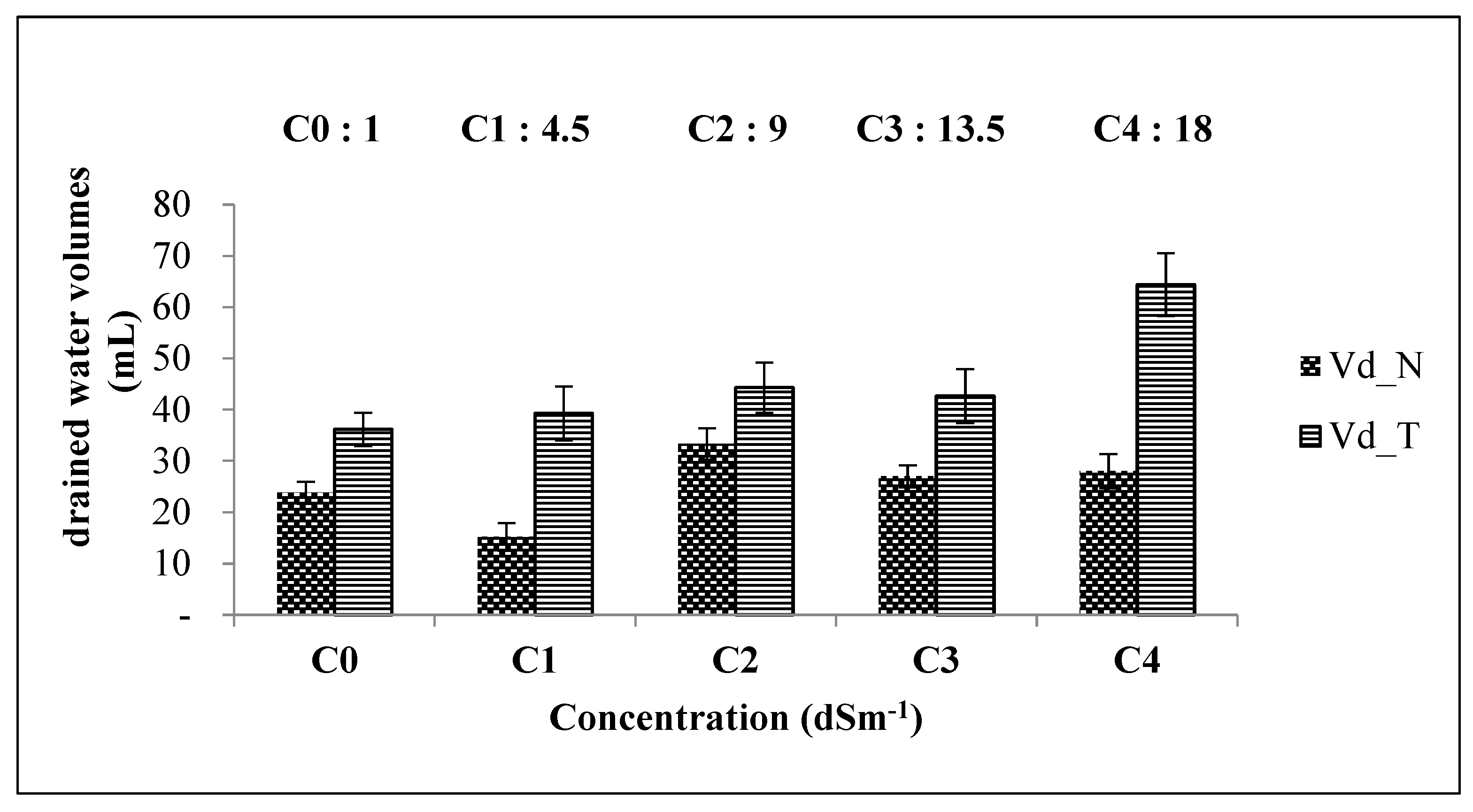


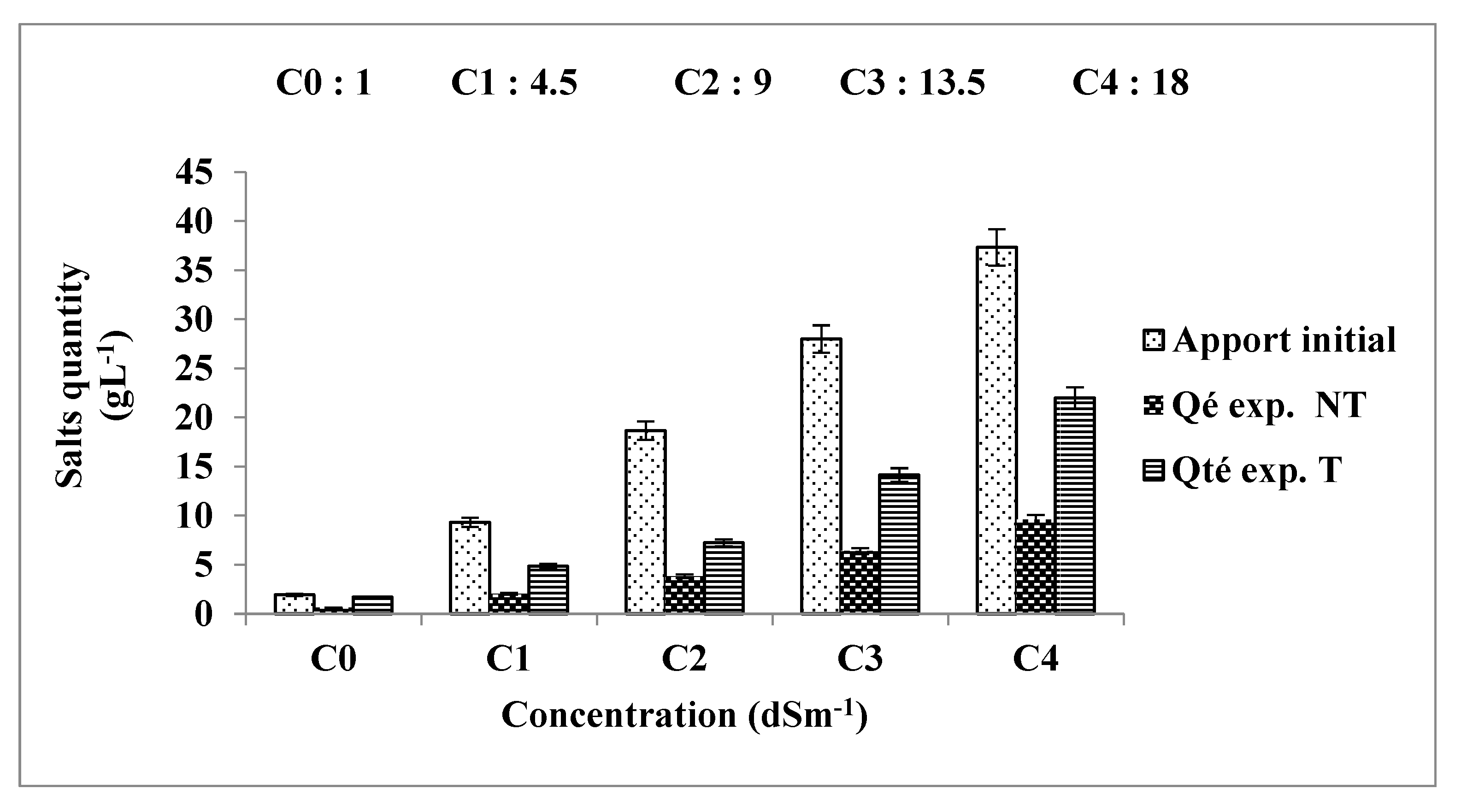
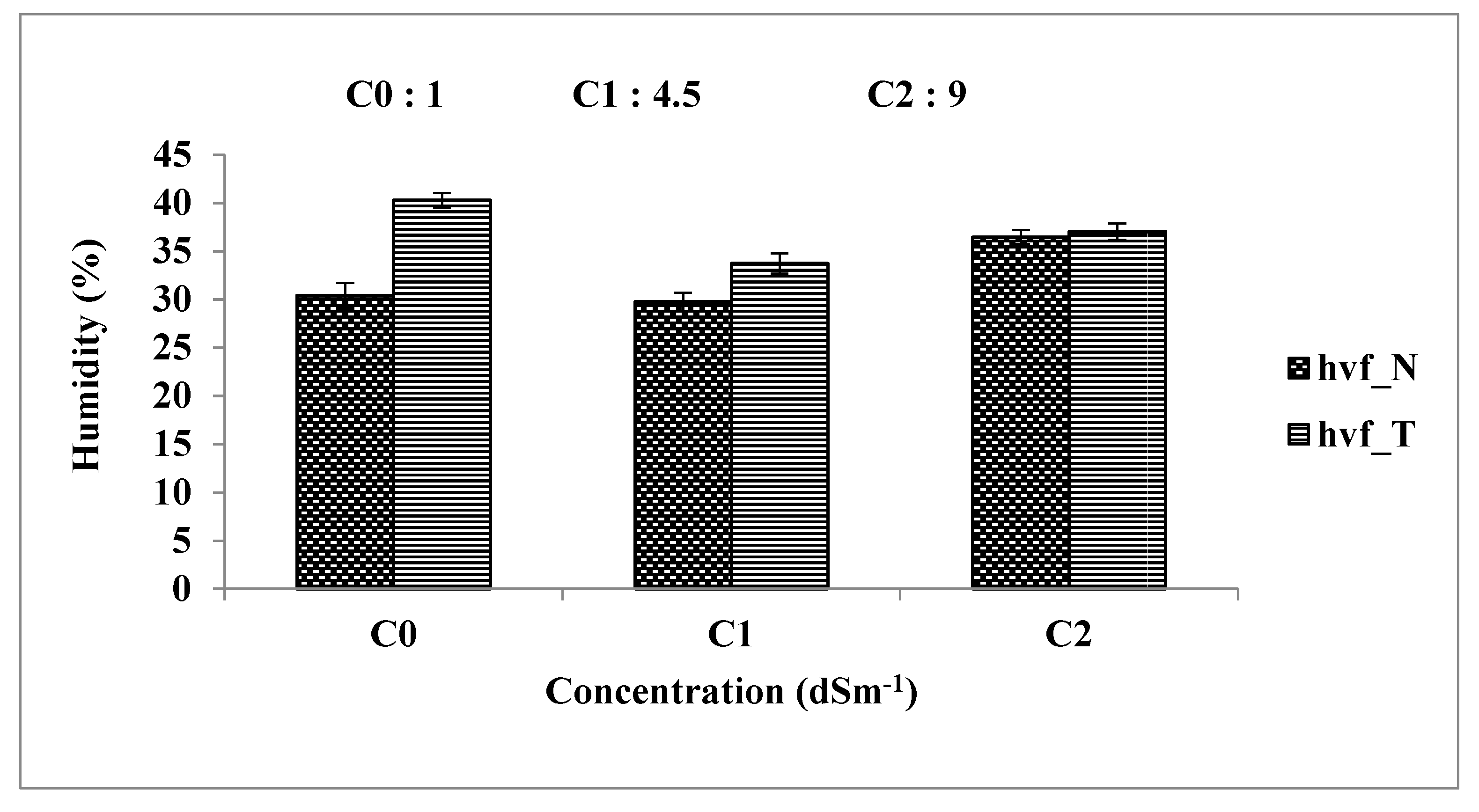
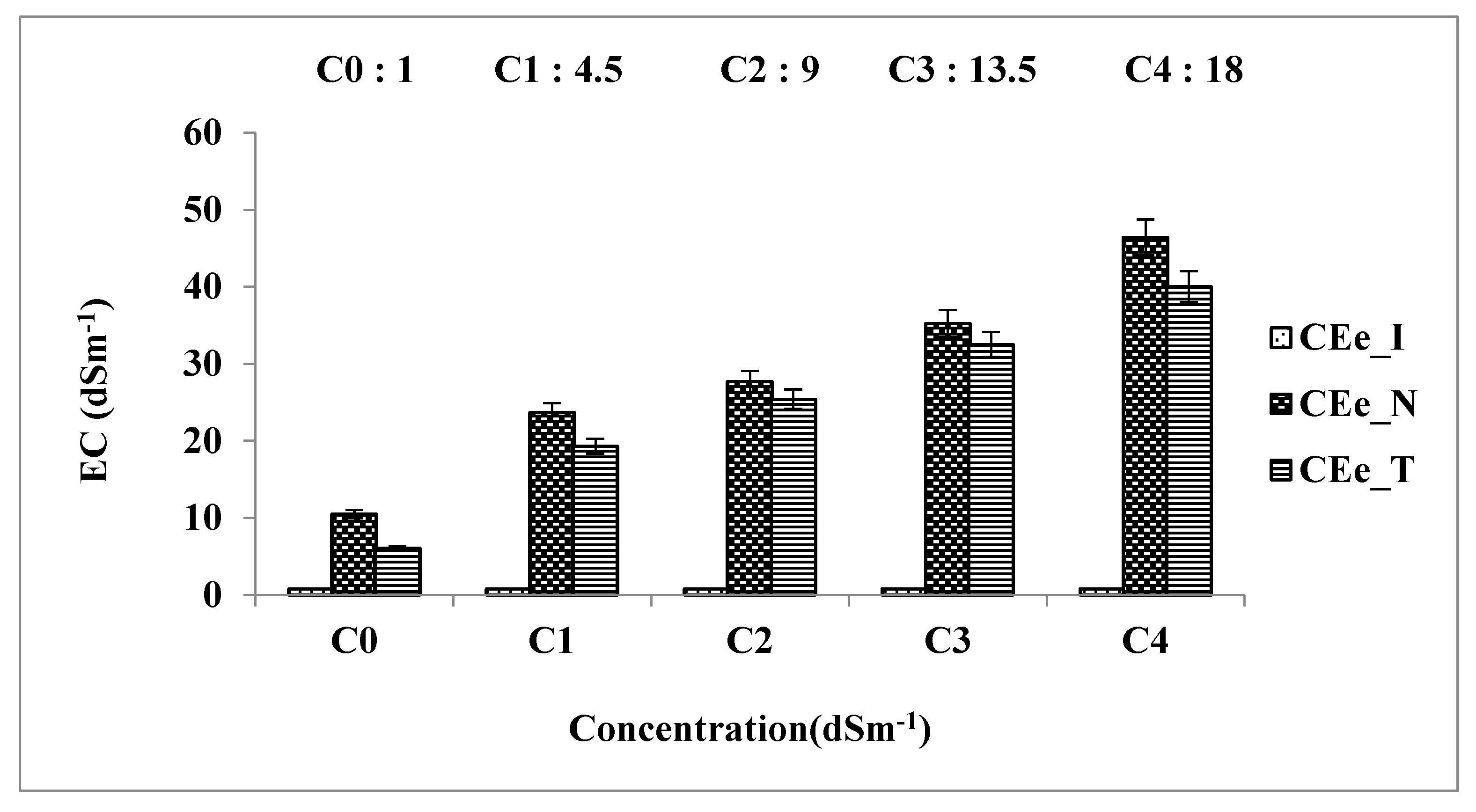




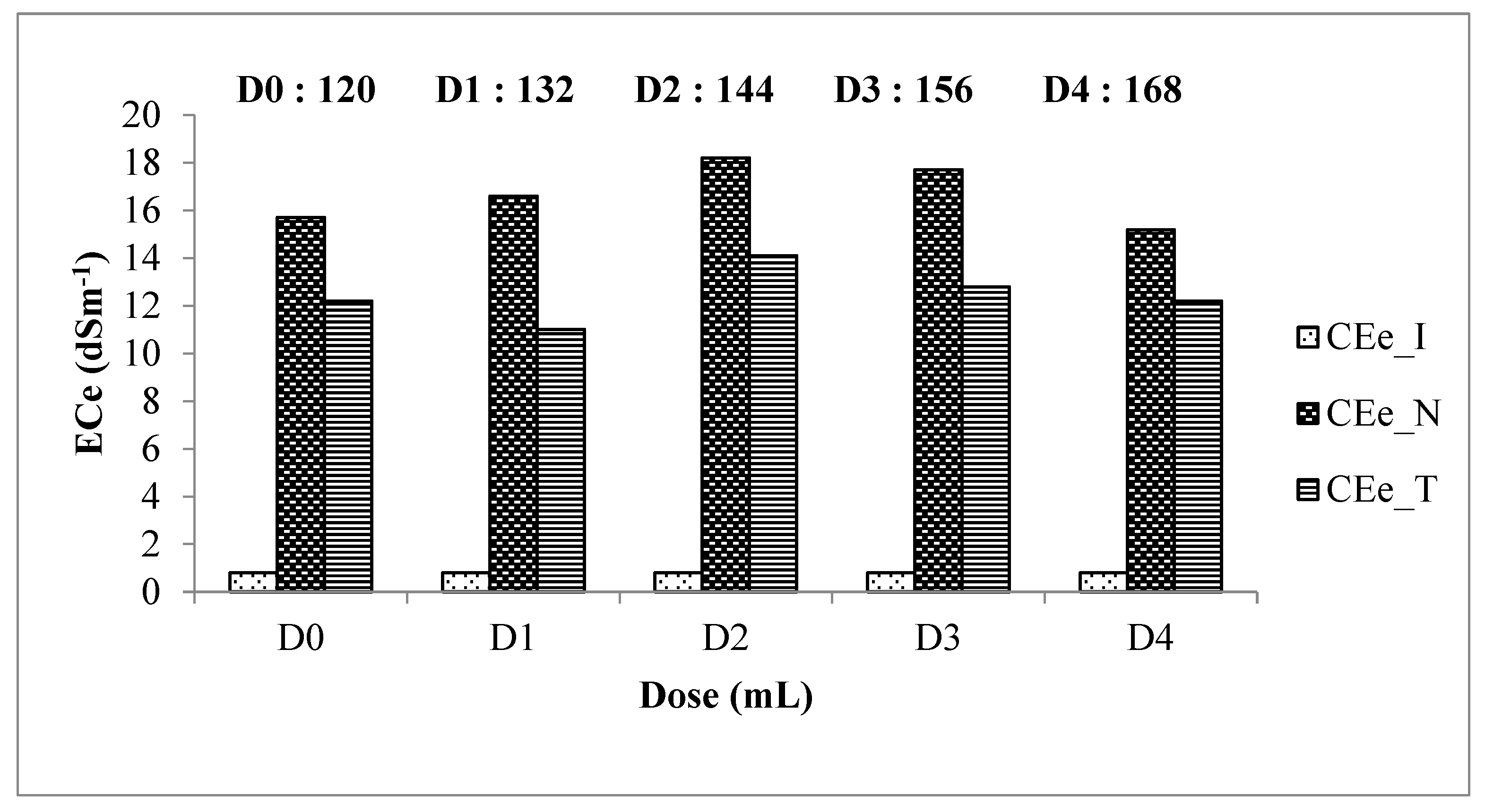



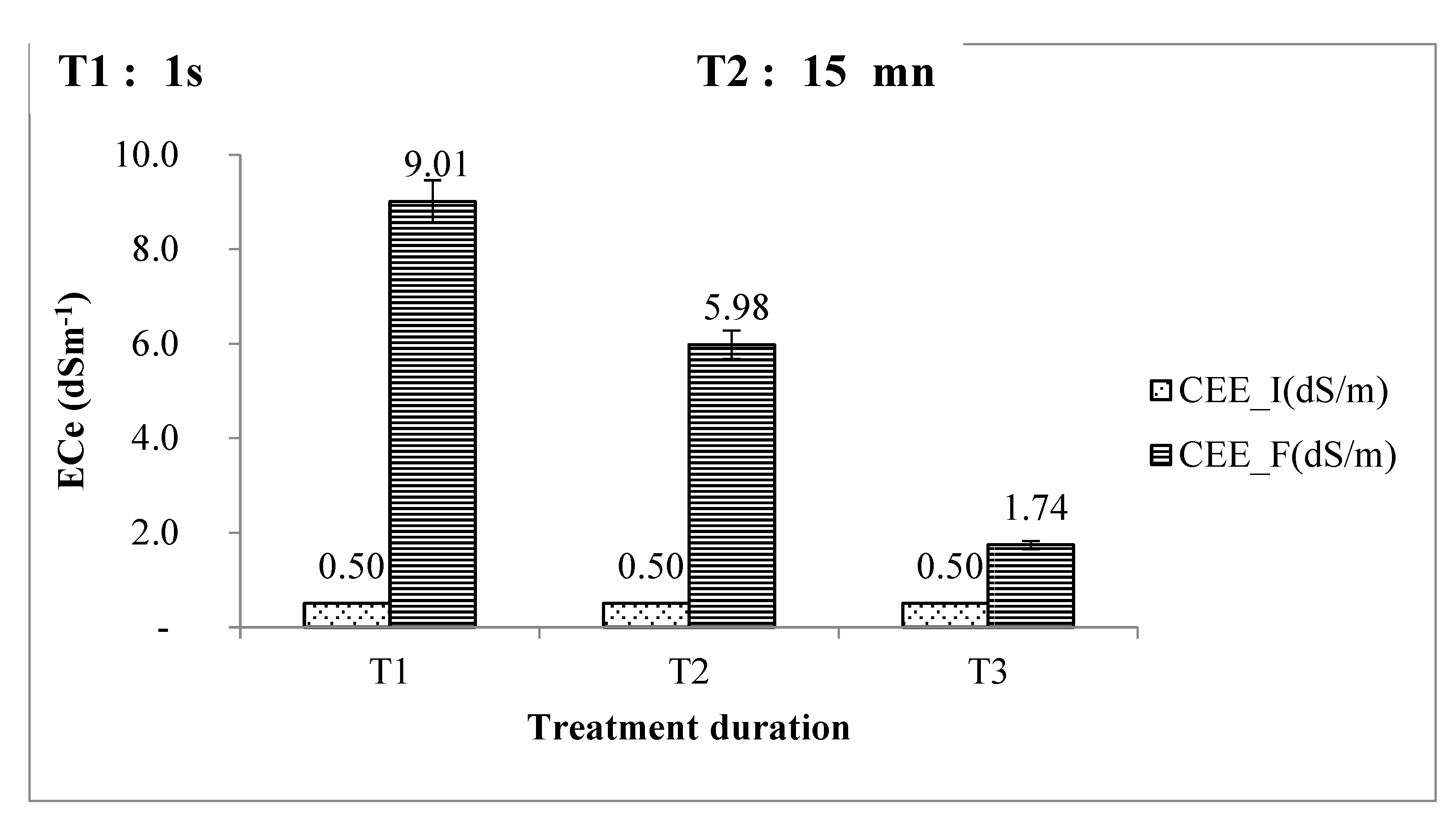
| Clay (%) | Silt (%) | Sand (%) | CaCO3 (%) | Organic matter (%) | Bulk density (g cm-3) |
pH | ECe (dS m-1) |
| 26 | 44 | 30 | 25 | 1.0 | 1.4 | 8.1 | 0.1 |
| Treatment | Ca2+ | Mg2+ | Na+ | K+ | Cl- | HCO3- | SO42- |
|---|---|---|---|---|---|---|---|
| EMT | |||||||
| C0 | 4.50 | 5.50 | 247.10 | 2.88 | 233.15 | 3.50 | 14.36 |
| C1 | 19.50 | 7.50 | 296.79 | 4.70 | 299.50 | 4.50 | 24.00 |
| C2 | 15.30 | 6.60 | 170.30 | 2.50 | 169.78 | 7.40 | 14.60 |
| C3 | 18.00 | 6.50 | 268.44 | 2.25 | 259.44 | 5.50 | 25.73 |
| C4 | 35.41 | 13.50 | 459.60 | 6.80 | 463.12 | 7.60 | 43.80 |
| NT | |||||||
| C0 | 10.50 | 3.50 | 150.23 | 1.78 | 145.12 | 4.50 | 18.20 |
| C1 | 17.00 | 12.00 | 154.78 | 1.90 | 160.20 | 5.50 | 17.80 |
| C2 | 15.00 | 6.50 | 160.70 | 1.87 | 153.69 | 6.50 | 22.63 |
| C3 | 17.80 | 9.50 | 212.89 | 2.74 | 220.23 | 8.00 | 21.34 |
| C4 | 32.50 | 12.00 | 451.14 | 4.25 | 445.56 | 7.00 | 45.59 |
| Treatment | Ca2+ | Mg2+ | Na+ | K+ | Cl- | HCO3- | SO42- |
|---|---|---|---|---|---|---|---|
| EMT* | |||||||
| C0 | 15.00 | 6.50 | 79.22 | 1.73 | 76.28 | 5.50 | 19.62 |
| C1 | 35.30 | 12.50 | 202.91 | 2.82 | 208.98 | 6.00 | 41.58 |
| C2 | 37.50 | 12.00 | 222.92 | 2.50 | 225.60 | 5.00 | 44.70 |
| C3 | 39.00 | 11.00 | 356.08 | 2.96 | 358.56 | 5.50 | 45.25 |
| C4 | 47.00 | 9.00 | 575.83 | 4.01 | 580.99 | 6.50 | 20.85 |
| NT** | |||||||
| C0 | 25.00 | 8.50 | 44.22 | 2.20 | 45.12 | 5.50 | 32.12 |
| C1 | 38.00 | 16.50 | 186.78 | 2.80 | 194.4 | 7.20 | 45.20 |
| C2 | 41.00 | 15.30 | 205.42 | 3.00 | 204.56 | 5.30 | 52.50 |
| C3 | 41.50 | 17.82 | 298.78 | 3.11 | 296.21 | 6.70 | 57.19 |
| C4 | 52.50 | 11.50 | 481.22 | 3.93 | 487.97 | 7.00 | 55.11 |
Disclaimer/Publisher’s Note: The statements, opinions and data contained in all publications are solely those of the individual author(s) and contributor(s) and not of MDPI and/or the editor(s). MDPI and/or the editor(s) disclaim responsibility for any injury to people or property resulting from any ideas, methods, instructions or products referred to in the content. |
© 2024 by the authors. Licensee MDPI, Basel, Switzerland. This article is an open access article distributed under the terms and conditions of the Creative Commons Attribution (CC BY) license (http://creativecommons.org/licenses/by/4.0/).




